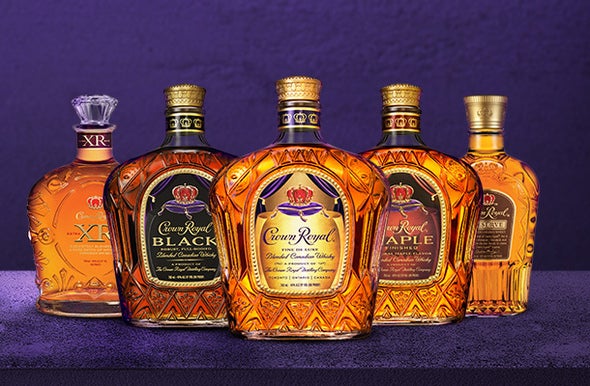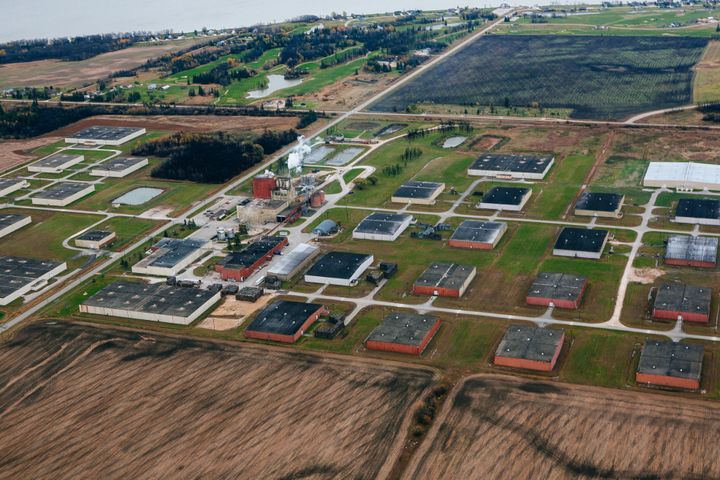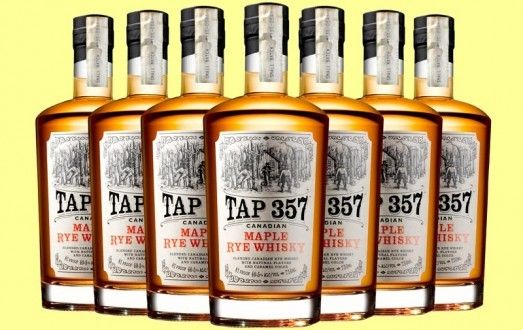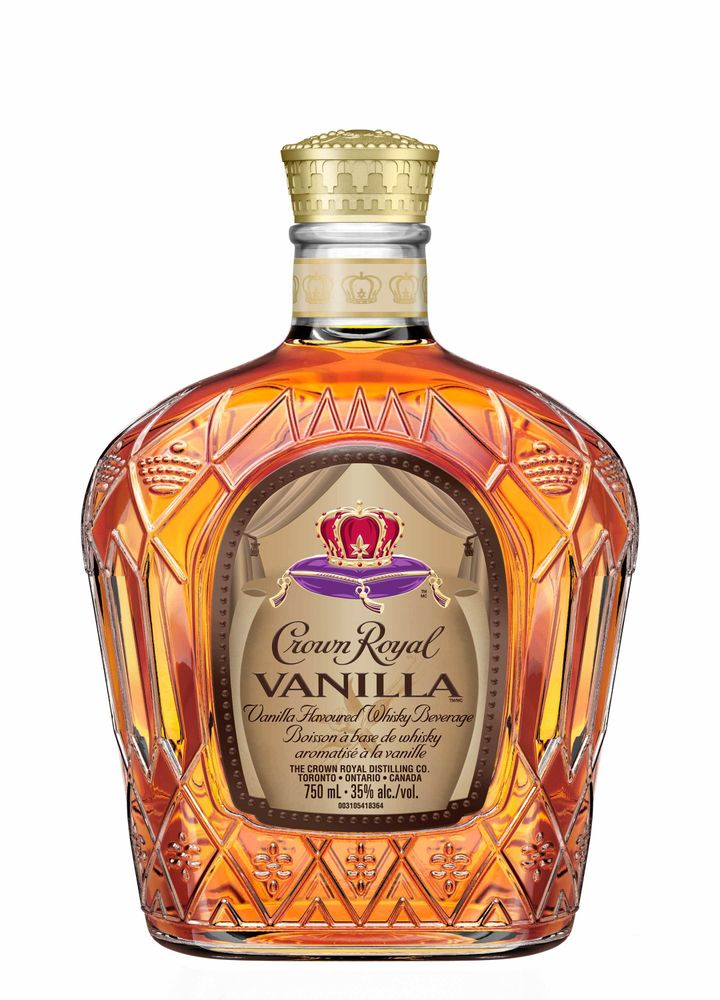
The core Crown Royal range consists of both flavored and regular Canadian whiskies.
Flavoring whiskies is a practice that is both uniquely Canadian and one that dates back to the early days of Canadian whisky. Originally, whisky production was associated with flour millers. Excess wheat, including any tailings from the flour milling, would be cooked and fermented into a wash and distilled. The product was called wheat whisky or common whisky. Originally primitive pot stills were used, but larger producers quickly graduated to continuous stills. The whisky was generally sold unaged and was relatively bland. In those cases where it was aged, it would be for periods of less than a year.
Like their southern neighbors, the preferred spirit in Canada in the 18th century was rum. The first Canadian distillery, set up in Quebec in 1769, produced rum from West Indies molasses. As settlers penetrated west into Ontario, however, the cost of transporting rum or molasses became prohibitively expensive. The Lachine Rapids, just below Montreal, and subsequent rapids blocked ships from travelling farther up the St. Lawrence River. An early system of locks eased the problem somewhat, but it wasn’t until the construction of the modern lock system of the St. Lawrence Seaway in the 1950’s, that ocean going freighters could travel unhindered from the western tip of Lake Superior to Anticosti Island at the mouth of the St. Lawrence.
Initially wheat whisky was added to rum to stretch available rum supplies. The concoction would have been somewhat reminiscent of modern light rums. The distillate added was referred to as high wine. It’s not clear whether it was the product of a single continuous distillation or of a double pot still distillation, most likely it was both. As settlers moved progressively west, however, the practice of blending wheat whisky with rum became impractical. Sometime in the early 19th century, at the suggestion of Dutch and German immigrants, wheat whisky began to be flavored with rye. It’s likely that initially rye flour would have been added to a mash of wheat flour and grist to add rye’s spicy flavors to the resulting whisky. This was the beginning of Canadian rye whisky.
The Canadian practice has been to ferment, distill and age different mash bills separately and then blend them prior to bottling. The addition of rye whisky to wheat whisky led the resulting whisky to be called rye whisky or Canadian rye whisky, even though the whisky was not necessarily based on a majority of rye grain. This is a significant difference from American rye whiskey producers. Their whisky must be made from a mash bill that is at least 51 percent rye grain.
The matter is further complicated by the unique nature of the rye grain. Rye grains only produce half as much alcohol per pound of weight as corn does. So even a mash bill that is 51 percent rye will still have a preponderance of corn or wheat derived alcohol and related congeners. Additionally, the further north rye is grown the greater the degree of spiciness and pepperiness it imparts to a whisky. That’s why Canadian whisky maker Crown Royal identifies its rye whisky, Jim Murray’s 2016 World Whisky of the Year, as “Northern Harvest Rye.” Hence, the amount of rye in a mash bill is not a good indication of how prevalent the signature aroma and flavor profile of rye will be. In any case, like rum, rye whisky was used as a flavoring agent to make otherwise bland whisky more favorable.

Continuous stills at the Crown Royal Distillery
At one point, Canadian regulations permitted the addition of 9.09 percent “non-Canadian whisky spirits,” including wines. This rule was changed effective July 1, 2009, so that it is now only applied to exports of Canadian whisky to the U.S. Canadian whisky sold domestically is not bound by the 9.09 percent limit, and can include any quantity of other spirit provided that the resulting whisky retains the aroma and flavor profile typical of Canadian whisky. It must have a minimum ABV of 40 percent, however, to be called Canadian whisky in Canada. Otherwise, it is referred to as a “whisky flavored beverage.” Crown Royal’s flavored whiskies sold in Canada are identical to those exported in the U.S. The Canadian version are described as a “whisky flavored beverage” while the U.S. versions still carry the “Canadian whisky” designation.
The 9.09 percent rule originally applied to the blending of other spirits into Canadian whisky. At some point, it’s not entirely clear when, the provision was interpreted broadly enough to include fortified wines like sherry and port and even nonalcoholic liquids like maple syrup, apple and vanilla flavorings. Finally, if the spirit blended with the Canadian whisky was at or under the 9.09 percent limit, its age would not be factored in determining the official age statement of the whisky and the product could still be identified as Canadian whisky. If the 9.09 percent threshold is exceeded, then the resulting spirit is classified as a generic whisky or a whisky flavored beverage and the age statement, if there is one, on the bottle must conform to the youngest age of the spirit in the blend.
According to Canadian whisky expert Davin de Kergommeaux, the 9.09 percent rule may have been the result of a negotiation between Seagram’s legendary founder Sam Bronfman and U.S. tax authorities. Following the repeal of Prohibition, alcohol imports into the U.S. were heavily taxed in order to give struggling domestic distillers the opportunity to reestablish their operations. Additionally, Canadian whisky was more expensive to produce since government regulations mandated a minimum aging period of three years. Canada was the first country to mandate a minimum three-year aging period, having done so in 1891. The British government didn’t follow suit until 25 years later, in 1916, when it largely copied the Canadian law to mandate a minimum three-year aging period for Scotch whisky.

The Crown Royal Distillery in Gimli, Manitoba
U.S. producers did not have any minimum aging periods. Most American whiskey was sold without an age statement, and was often blended with inexpensive neutral grain alcohol. A provision in the U.S. excise tax on alcohol lowered the tariff on foreign spirits that included a portion of American distilled whiskeys in their blend. According to Kergommeaux, Bronfman negotiated an agreement for a lower tariff on Canadian whisky that incorporated a 1/11th portion of American whiskey, hence the 9.09 percent figure. To be clear, Kergommeaux doesn’t vouch for the story, he simply reported the prevailing scuttlebutt.
Crown Royal, the Gimli based Canadian distiller owned by Diageo, was the first major producer to begin experimenting with non-traditional flavorings in its Crown Royal Canadian whisky, although it was not the first distillery to release flavored whiskies.This was a natural extension of the longstanding practice of flavoring Canadian whisky with more flavorful spirits. In this case, however, rather than being other whiskies, the different flavors were the result of other flavored additives or different finishing techniques.
Their first release, in November 2012, was Crown Royal Maple Finished. The product was described in Canada as a “maple flavored whisky beverage,” which is produced by adding “natural maple flavoring” and finishing the whisky in “maple toasted oak.” According to the distillery, these are staves and chips of oak that have been specially toasted using a proprietary process to bring out their “natural maple like flavor and aroma” characteristics.
Since then a variety of Canadian whisky companies have introduced a broad array of flavored whiskies ranging from pecan pie, to pumpkin spice, to coffee and caramel flavors. Among the major producers of flavored whiskies are: Black Velvet, Alberta Distillers (ADL), Forty Creek, Canadian Mist, Highwood, Hiram Walker, Canadian Club, Phillips and Spicebox. In addition, there are a range of small independents and micro-distillers that also produce flavored whiskies as well.
All told there are now around 50 flavored Canadian whiskies from over a dozen producers. The flavors range from sweet (caramel, vanilla, and maple), fruity (cherry, apple, peach and blackberry), spicy (cinnamon), exotic flavors (coffee, hops, chocolate, pecan pie) to cream-like liqueurs. Flavored whiskies, while similar to whisky liqueurs, differ primarily in the amount of residual sugars. Most flavored Canadian whiskies do not contain additional sugars, other than what is included as part of the flavoring agent. Flavored Canadian whiskies typically average about 40 grams of sugar per liter. Liqueurs typically contain a minimum of 100 grams of sugar per liter and can contain as much as 300 grams per liter.

Tap 357 Maple Rye Whisky
Among the first companies, in January 2012, to release a flavored whisky was TAP 357, Canadian Maple Rye Whisky. Tap 357 is a mix of Blended Canadian Rye Whisky aged three, five and seven years, hence the term 357, combined with Canada 1/Grade A light maple syrup from Quebec. The term “tap” refers to the practice of tapping maple trees in the spring to obtain sap, which is then boiled down to make maple syrup. The earliest sap is considered to make the best tasting maple syrup. It is the first flavored rye whisky to appear in Canada. The rye whisky used in TAP 357 is produced at Alberta Distillers in western Canada, where it is distilled four times for smoothness, then matured in a combination of new, second- and third-use bourbon barrels.
The terms used to identify the flavoring agents may not always be exactly as described. A maple-finished whisky may be a blend of Canadian whisky and maple syrup or it may be a blend of a maple flavored additive. Likewise, a sherry flavored or port flavored whisky may not necessarily contain Spanish sherry or Portuguese port. In the case of sherry, it may be paxarette, a boiled sherry concentrate that imparts pronounced sweet sherry flavors or it can be a sherry-like wine that may have nothing to do with sherry from Jerez, Spain. Likewise, a port finish/flavor may have nothing to do with the fortified Portuguese wine produced in the Douro. It may simply be any port-like wine.
There are obvious parallels between the Canadian practice of flavored whiskies and the Scotch industry’s practice of finishing whiskies in barrels that contained other liquids. The Scotch Whisky Association (SWA) rules are clear, however, that only barrels that are customarily used to store a liquid can be used to cask finish a Scotch whisky. Sherry butts can be used for cask finishing. But the use of paxarette to treat barrels to impart sherry-like flavors is not permitted since paxarette is not typically stored or aged in barrels. Likewise, vanilla or pecan pie flavored Scotch whisky is not in the cards since neither substance is normally stored or aged in an oak barrel.
Below are several tasting notes from a selection of Canadian flavored whiskies.

Crown Royal, Maple Finished, Maple Flavored Whisky Beverage, NAS, 750 ml, 40% ABV
Crown Royal uses caramel coloring to give its flavored whiskies a consistent color. The whiskies all exhibit a dark amber color.
On the nose the sweet aroma of maple syrup bordering on butterscotch is unmistakable. There are some floral and vanilla notes in the background, but these may be part of the maple flavoring. There is a lingering waxiness and creaminess that hints slightly of furniture wax, as well as some wood spice notes of cinnamon and allspice.
On the palate, the whisky is initially much drier than the sweet maple aromas would have indicated but the sweetness gradually builds back up. There are distinctive caramel and vanilla notes, followed by some cooked cereal notes in the background. There is also some wood spice, especially cinnamon, and a bit of oak. The whisky itself feels slightly viscous with a heavier mouth feel, no doubt a result of the higher sugar levels imparted by the maple flavoring.
The finish is long with a distinctive sweet, maple flavor, with vanilla and cinnamon notes that hang on the palate for a long time.
This is an interesting whisky. If you think that maple syrup with a dash of whisky is the ultimate accompaniment to pancakes, then this whisky is for you. It’s an excellent sipping whisky, that is equally useful both in mixology and cooking. Think of it as a libation for grownups that will work equally well in any role previously reserved for either whisky or maple syrup.
Appearance 7/10, Nose 25/30, Palate 27/30, Finish 27/30, Overall Score: 86/100

Crown Royal, Vanilla Flavored Whisky, NAS, 750 ml, 35% ABV
This whisky is made by infusing Crown Royal whisky with a concentrated flavoring agent made from Madagascar Bourbon vanilla, widely considered the world’s most flavorful vanilla. On the nose, the whisky has a predictable, sweet, vanilla aroma. There are hints of creamy butterscotch, followed by some slight cinnamon and clove notes, and even a bit of coconut.
On the palate, there is an oily viscous quality that creates notable weight on the palate. The vanilla flavors are pronounced throughout with some wood spice, especially cinnamon, emerging mid-palate and a distinctive sugar sweet note emerging at the end. The finish is long, with a pronounced sweet vanilla note.
This whisky is exactly what it advertises, a vanilla flavored whisky. It’s not for everyone, but if you enjoy whisky based liqueurs it has many of the attributes of liqueurs without the heavy sweetness that characterizes them.
Appearance 7/10, Nose 25/10, Palate 26/10, Finish 25/10. Overall Score: 83/100

Crown Royal, Honey Flavored Whisky, NAS, 750 ml, 35% ABV
Honey and spirits go well together. Honey was probably the first substance mixed with early whisky in order to make it palatable, and it has remained a popular combination among liqueur makers. On the nose, there is an unmistakable aroma of sweet honey and spirit with a hint of beeswax and oak. On the palate, there is an oily, smooth viscous sweetness, but it stops short of the syrupiness of a liqueur. According to Crown Royal, the honey is made from sweet wild clover and sunflowers. Complementing the honey are some wood spice flavors typical of Crown Royal, especially a cinnamon note. The finish is long and as you would expect, sweet but not particularly nuanced or complex.
Appearance 7/10, Nose 27/10, Palate 27/10, Finish 25/10. Overall Score: 86/100

Crown Royal, Regal Apple, Apple Flavored Whisky, NAS, 750ml, 35% ABV
According to the distillery, “Crown Royal Regal Apple is produced ...with the apples in a mixture of water and alcohol. We then distill the mixture and collect selections based on aroma. The aromatic fractions are blended to achieve the final apple flavor characteristics of the Regal Gala apple.”
On the nose, there is the distinctive spicy, green apple aroma you would expect. The aroma profile seems like a combination of fresh ripe green apple and baked candied cinnamon apple or a fresh apple pie. There is a notable aroma of wood spice including vanilla, cinnamon and a little clove, as well as a waxy, furniture polish like aroma in the background.
On the palate, there is a distinct sweetness that is a nice contrast to an initial bitter note. The whisky has a viscous oily creamy quality with a pronounced mouth weight. There are wood spice aromas of vanilla, and cinnamon with a hint of nutmeg as well as some brown sugar notes. The finish is long with pronounced apple flavors, accompanied by sweet and bitter notes.
An interesting whisky, vaguely reminiscent of a Calvados or apple brandy, but far sweeter with a more pronounced cooked apple aroma. Not sweet enough to be a liqueur, but highly unusual for a whisky.
Appearance 7/10, Nose 26/30, Palate 27/30, Finish 27/30. Overall Score: 87/100

Tap 357, Canadian Maple Rye Whisky, NAS, 750ml, 40.5% ABV
The color is a gold or light amber color. On the nose, there is an unmistakable aroma of fresh maple syrup. The aroma is rich, with maple and caramel sweetness throughout set against a strong spirit note. There are noticeable wood spices of vanilla and cinnamon, with a hint of pepper produced by both the rye grains and the oak wood in which the spirit is aged.
On the palate, the whisky is drier than the aroma would have suggested, but a sweet note steadily builds up and lingers on the end accompanied by vanilla and cinnamon notes and a slight hint of pepper. The finish is long and lingering, with a pronounced maple flavor contrasted by a slight bitter note and peppery flavors.
Appearance 7/10, Nose 27/30, Palate 28/30, Finish 27/30. Overall Score: 89/100
